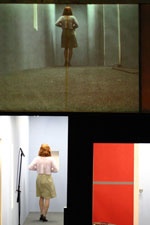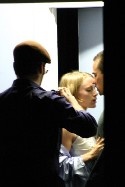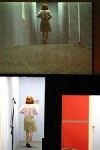Jay Scheib's This Place is a Desert
ICA Hosts World Premiere
By: Erica H. Adams - Mar 28, 2007
The Institute of Contemporary Art's world premiere of This Place is a Desert, March 22 –25th, advertised as theater for a generation raised on cinema, posed vital contemporary issues of isolation, violence and surveillance in a Post 9/11 culture that freely mixes fact with fiction. Conceived and directed by Jay Scheib, this production is his 20th collaboration since 1996, with media specialist Leah Gelpe and was produced by Shoshana Polanco.
At the ICA's Water Café, before Thursday's premiere Scheib spoke about working on his family's Minnesota farm plowing a field: he realized, he could only finish one small section of the field at a time but, that he "was able to change the earth, incrementally".
Living in New York through the events of 9/11, Scheib witnessed in its aftermath, the frightening rise of reality television and the media's willful construction of news from re-purposed facts and, fiction. Even Michael Moore, he said was 'propaganda'. For the next three years, Scheib worked in Europe, in self-exile.
The current production of This Place is a Desert was begun as a workshop with the Kretakor Ensemble in Budapest, was developed in residence at Massachusetts Institute of Technology, where Scheib is a theater professor and was part of an open studio showing at the Prelude Festival in New York in 2005.
Scheib met Gelpe at Columbia University in the late '90's where she studied film and he studied with director Robert Woodruff and Anne Bogart. Gelpe was the video artist for A.R.T. director Woodruff's production of Brittanicus and Island of Slaves before his recent departure to the San Francisco Opera.
At the ICA/Boston premiere, Scheib and Gelpe's 'motion portrait' read like a voyeurist's tableau vivant: vignettes of stylish, clueless and violent 21st century couplings -ill conceived and run amok –were filmed and projected onto four screens through live-feeds over the staged actions below. Their production's hybrid form followed dysfunction as Scheib explains:
"So from ecological point of view we ask the question: Are we ugly people? And therefore deserving of the ugliness of the world that we live. Or is there something wrong in us? Something that needs to be fixed? And the world in which we live is merely symptomatic of a deeper anxiety . . . From another point of view: why, when we are always feeling bad, are we inspired to make things worse?"
Inspired by filmmaker Antonioni, master of the erotic partial view, one of the four staged actions was only visible on screen. The 'prismatic views' of four simultaneously staged and filmed actions exceeded Shakespeare's theater-in-the-round with fewer angles than a cubist painting and delivered perceived depths of jewel cut, faceted surface. Like a house of mirrors, each scene refracted a single dysfunction: fear of intimacy in a field of accidents. These 'vision tools' Gelpe said, of the staged, filmed and replicated actions, allowed the play to develop 'organically'.
Throughout the performance, cameras and their technicians moved freely among actors, like the black clothed Kabuki kuroko (stage hands) we're not supposed to notice, this artifice engendered a parallel world.
Structurally, ICA/Boston's theater, like a sports arena, posits all staged action at a steep incline, far below audiences. It was easier to watch screens placed at eye level with live action close-ups than the stage. In part, this generalized situation has contributed to our preference for film over real life (R.L.) and, underlines a major theme of this production. While living in a culture of screens has allowed us to communicate globally, it has isolated us, locally.
During the opening sequences of the play, as the crew and actors set up, the audience continued to talk, uncertain it had begun, when in fact, the intentional blurring of real, staged and filmed action was already in-process. In one corner, a woman read a book by short story writer Raymond Carver, the first of many women readers savagely interrupted by potential sex partners. The one man who admitted to taking pleasure in watching a woman read, paid her to beat him, as well. Readers punctuated the set, marking time as book covers posed as symbolic content, in this action-based desert of sleepwalkers. Awkward couplings included ritualized violence often followed by spasmodic break dances and the occasional ballet.
Rhythms, as much dance as visual music, constructed themes and accrued a sense of dread, not parody. Dialogue pierced the air like bullets in chilly, Pinteresque scenes of miscommunication. This Place is a Desert exposed narcissists addicted to velocity:
Emily: (wiping blood from her lip) I am not into philosophy, I'm into the military. I'm into bullets, I like speed, I'm into intelligence—seeing more than my opponent sees. I love missiles that pilot themselves; missiles that see. Do you get it? Ideasdon't interest me anymore, or history; I am interested in velocity. And that's really it. This Place is a Desert.
The inability to focus on any one scene of this complex network replicated a contemporary phenomenon of relentless motion, one that's sleepless, dreamless and numb; it's productivity-oriented, but produces little of worth. This Place is a Desert began as it ended with a blur, in process. A phantasm; a thousand arrows were shot into the air, some still in suspension, others lodged deeply through our bodies into the next day: hard to shake, hard to take. Scheib quotes Philip K. Dick: "Reality is that which when you stop believing in it, it doesn't go away."
Scheib's recent works include the critically acclaimed Women Dreamt Horses at PS122 in New York; a multimedia adaptation of Tolstoy's The Power of Darkness; at Trafo in Budapest; a live art installation All Good Everything Good at Raum Space, Bologna Italy, and the world premier of Irena Popovic's opera Mozart Luster Lustik at the Sava Center in Belgrade; Other credits include: The Medea after Heiner Müller and Euripides at La Mama in New York with subsequent performances in Turkey; The Demolition Downtown by Tennessee Williams at MIT; Musset's Lorenzaccio at the Loeb Drama Center; Koltès' West Pier at the Ohio Theatre; Falling and Waving, at St. Ann's in Brooklyn. He is winner of the Richard Sherwood Award, The Wade Award and numerous fellowships. Scheib is currently assistant professor of theatre at MIT, and a regular guest professor at the Mozarteum Institute für Schauspiel und Regie, in Salzburg, Austria. He holds an MFA from Columbia University.
Leah Gelpe has collaborated with Scheib on 15 productions since 1996, including The Power of Darkness, The Medea, West Pier and Falling and Waving. She was video designer for Brittanicus and Island of Slaves at the ART, and sound designer for David Rabe's The Black Monk at Yale Rep, The Lady from the Sea at the Intiman Theatre, Saved at Theatre for a New Audience, and Godard (distant & right) at the Ohio Theatre in New York and Theatre des Amandiers, Nanterre, Paris. She holds an MFA in film from Columbia University.
Producer Shoshana Polanco has been creating, producing, and performing original work since 1997. Her latest ventures have been La Perla in her native Buenos Aires, committed in New York and Pedestrian: A Walking Tour for Multiple Voices and Portable Phones in New York. She was Creative Producer of BAiT - Buenos Aires in Translation, a festival of 4 English-Language World Premieres at PS122 in New York.






